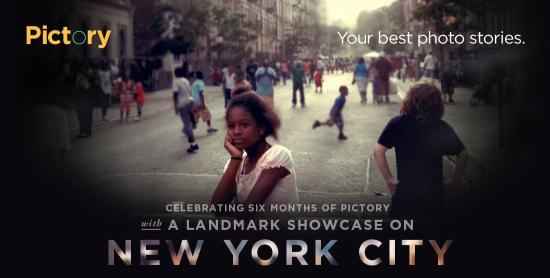Here at Storyboard, we've written before on the question of words and captions in relation to photos, so we were intrigued by Pictory, an online photography site that assembles images and narrative captions into a larger story for each issue. We talked this week by phone with Pictory’s editor and designer, San Francisco-based Laura Brunow Miner. Former editor-in-chief of JPG Magazine, Miner has a background in print design but says she’s been into photography since her first job at a photo lab at the age of 16. Here are excerpts from our chat, in which she dishes about creating narrative from submitted content, takes issue with claims to novelty in digital storytelling, and considers the issue of truthfulness in reader-generated content.
What exactly is Pictory?
 It’s sort of like The Boston Globe’s The Big Picture, except that anyone can submit a captioned photo on one of my themes, such as “Overseas and Overwhelmed.” I select from the submissions and put together a show based on the theme.
It’s sort of like The Boston Globe’s The Big Picture, except that anyone can submit a captioned photo on one of my themes, such as “Overseas and Overwhelmed.” I select from the submissions and put together a show based on the theme.
Who’s submitting pictures? Are they local, or do contributors come from all over?
They really come from all over the world. I feel lucky in the diversity of submissions that I get. I think it was for “Coming Home,” I had pictures from Hong Kong. I somehow have regular submitters from Moscow. I have no idea how it happens. For “Neighborhood Treasure,” I had people from Mississippi and from off the coast of North Carolina.
It’s an interesting interplay of photos and explanation. Most of the images have longer captions than you’d see in newspapers or magazines, or even online. Do you see the role of the caption as central to the site?
Absolutely. It makes it so much more meaningful. I often describe it as the difference between going into a museum and seeing the pictures as opposed to doing a tour with the curator, or an audio tour. I try to be the tour with the curator. I try to pick out the best of what comes in and make it into something.
Do you get a similar level of response to different calls for photos, or does the quantity of submissions vary?
It varies wildly, but from my time at JPG Magazine, I have a good understanding of what people have photos of already... I’ve probably seen tens of thousands of images in my career. Some of my themes have not gotten as many submissions, but I've never had to hunt down submitters, on Flickr or elsewhere.
Why did you start Pictory?
As JPG had financial issues and the print version went under, people in the office were talking about how it should be online in PDF form [see JPG's current site here—Ed.]. But I felt like that that wasn’t the right format. I’ve been very inspired by The Big Picture, because that was the first time we realized that photos could look as good online as they did in print.
What would you see as success for Pictory?
I plan to have this be a profitable business that does sustain at least one employee. I would love for it to be an example for journalists that one person can create a site and make a living from it.
Do you think it’s already successful in terms of design and content?
That’s hard to say. I think it can get better and hope it will be better over time. I've had lots of ideas of future possibilities, like in the future, as it’s easier for people to do short documentary films, I would love to include something like that. I would love to make an iPad app and maybe have guest musicians in addition to guest designers and guest editors. I think a picture book is extremely likely—I’ve had casual conversations about it already, but it’s too soon.
There are a lot of exciting directions I can go with this. As a basic idea, I feel really fulfilled by it, working with people who are not necessarily experienced professionals but who realize they have a story to tell.
Do you get many journalists contributing so far—many professional photographers?
I get a whole mix. I know a lot of journalists, and I know a lot of professional photographers. Since the site is six months old, half the people are still within two or three degrees of separation.
I think in general, people are drawn to it because they have a story to tell. It takes a certain kind of photo more than it takes a great deal of experience. Being included tends to depend on whether or not they have something to express—particularly with more emotional themes.
Do you think Pictory is a new frontier in visual storytelling? Is there anything you’re doing that no one else is?
The current CPM market structure doesn’t encourage a quality viewing experience—you can see exactly what it encourages on sites like The Huffington Post. We’ve all seen the different little numbers to click and click to get to page 12 of a piece. There are only a few people focusing entirely on reader service, on a great experience for the audience. I feel that’s something I’m doing differently.
A lot of people have said they feel they see joy in my craft, and that’s definitely true. I put a lot of passion into the details.
Do you have a favorite theme out of those you’ve done so far?
I really love “The One Who Got Away.” I feel so lucky that people shared their extremely personal stories. I think that’s the one that’s made the most people cry. All the time, quotes stand out in my brain. There’s this great one about a friend who graduated from law school and ended up suing her best friend’s family—the last line was “welcome to adult issues.”
There’s another really beautiful one where a broken-hearted guy talks about how you never know where your peaks and valleys of happiness are. There’s all these really beautiful stories people have to tell.
Another one that was really strong was “Life Before Your Eyes.” That came from the call for “my most meaningful image,” but it ended up with a different title.
Obviously, each picture is a little story, but do you think it of a larger story as you’re working on the order? Do you look for narrative movement?
That’s a huge part of my process, and a really enjoyable part of it. You can’t help but making an editorial statement with the order. Dealing with death, I’ve tried to place the images in an order moving toward people who had found release for their grief or recovery, so there would be an arc there.
Do you think what you’re doing is a new way of thinking about storytelling? Are we moving to new kinds of storytelling in the digital era?
I’m kind of funny. As much of a total techie as I am, I don’t really believe the world is fundamentally different. A lot of the important visual storytelling I’ve been encountering lately is in books and film. I live in a city and I’m in a community where we all think everything we're doing is brand new, that nothing like it has ever been done before, but I’m not really of that school of thought. I’m very inspired by Studs Terkel, This American Life, and Miranda July and Harrell Fletcher’s Learning to Love You More. Also, Welcome Books, which tends to do documentary though photography.
Is there anything else you’d like to say about Pictory?
I don’t think of Pictory as an art project, but I do think of it as art therapy. I think that people really benefit from telling their stories. I think I give them an appropriate and exciting way to do that.
Do you worry about whether they’re true stories, or whether people misrepresent events?
I really don’t, to be perfectly honest. There’s really no way for me to know. I haven’t run a theme yet where it’s a life-or-death situation whether or not it’s true. In one Featured Contributor interview, there were some stories that seemed like they might not be true, and I tried to work that into my introduction. But I think that’s not that different than Studs Terkel’s oral histories—I’m sure some people exaggerated or misrepresented sometimes with him. But the work I’m doing is not work where people’s lives are at stake—at the end of the day, nobody is really hurt in this arena.
I do feel like I have a responsibility as an editor to handle it appropriately. If you’re reading through and you can tell something is untrue, and it changes the experience of the viewer, then in that situation I would say yes, I would do something.

What exactly is Pictory?
 It’s sort of like The Boston Globe’s The Big Picture, except that anyone can submit a captioned photo on one of my themes, such as “Overseas and Overwhelmed.” I select from the submissions and put together a show based on the theme.
It’s sort of like The Boston Globe’s The Big Picture, except that anyone can submit a captioned photo on one of my themes, such as “Overseas and Overwhelmed.” I select from the submissions and put together a show based on the theme.Who’s submitting pictures? Are they local, or do contributors come from all over?
They really come from all over the world. I feel lucky in the diversity of submissions that I get. I think it was for “Coming Home,” I had pictures from Hong Kong. I somehow have regular submitters from Moscow. I have no idea how it happens. For “Neighborhood Treasure,” I had people from Mississippi and from off the coast of North Carolina.
It’s an interesting interplay of photos and explanation. Most of the images have longer captions than you’d see in newspapers or magazines, or even online. Do you see the role of the caption as central to the site?
Absolutely. It makes it so much more meaningful. I often describe it as the difference between going into a museum and seeing the pictures as opposed to doing a tour with the curator, or an audio tour. I try to be the tour with the curator. I try to pick out the best of what comes in and make it into something.
Do you get a similar level of response to different calls for photos, or does the quantity of submissions vary?
It varies wildly, but from my time at JPG Magazine, I have a good understanding of what people have photos of already... I’ve probably seen tens of thousands of images in my career. Some of my themes have not gotten as many submissions, but I've never had to hunt down submitters, on Flickr or elsewhere.
Why did you start Pictory?
As JPG had financial issues and the print version went under, people in the office were talking about how it should be online in PDF form [see JPG's current site here—Ed.]. But I felt like that that wasn’t the right format. I’ve been very inspired by The Big Picture, because that was the first time we realized that photos could look as good online as they did in print.
What would you see as success for Pictory?
I plan to have this be a profitable business that does sustain at least one employee. I would love for it to be an example for journalists that one person can create a site and make a living from it.
Do you think it’s already successful in terms of design and content?
That’s hard to say. I think it can get better and hope it will be better over time. I've had lots of ideas of future possibilities, like in the future, as it’s easier for people to do short documentary films, I would love to include something like that. I would love to make an iPad app and maybe have guest musicians in addition to guest designers and guest editors. I think a picture book is extremely likely—I’ve had casual conversations about it already, but it’s too soon.
There are a lot of exciting directions I can go with this. As a basic idea, I feel really fulfilled by it, working with people who are not necessarily experienced professionals but who realize they have a story to tell.
Do you get many journalists contributing so far—many professional photographers?
I get a whole mix. I know a lot of journalists, and I know a lot of professional photographers. Since the site is six months old, half the people are still within two or three degrees of separation.
I think in general, people are drawn to it because they have a story to tell. It takes a certain kind of photo more than it takes a great deal of experience. Being included tends to depend on whether or not they have something to express—particularly with more emotional themes.
Do you think Pictory is a new frontier in visual storytelling? Is there anything you’re doing that no one else is?
The current CPM market structure doesn’t encourage a quality viewing experience—you can see exactly what it encourages on sites like The Huffington Post. We’ve all seen the different little numbers to click and click to get to page 12 of a piece. There are only a few people focusing entirely on reader service, on a great experience for the audience. I feel that’s something I’m doing differently.
A lot of people have said they feel they see joy in my craft, and that’s definitely true. I put a lot of passion into the details.
Do you have a favorite theme out of those you’ve done so far?
I really love “The One Who Got Away.” I feel so lucky that people shared their extremely personal stories. I think that’s the one that’s made the most people cry. All the time, quotes stand out in my brain. There’s this great one about a friend who graduated from law school and ended up suing her best friend’s family—the last line was “welcome to adult issues.”
There’s another really beautiful one where a broken-hearted guy talks about how you never know where your peaks and valleys of happiness are. There’s all these really beautiful stories people have to tell.
Another one that was really strong was “Life Before Your Eyes.” That came from the call for “my most meaningful image,” but it ended up with a different title.
Obviously, each picture is a little story, but do you think it of a larger story as you’re working on the order? Do you look for narrative movement?
That’s a huge part of my process, and a really enjoyable part of it. You can’t help but making an editorial statement with the order. Dealing with death, I’ve tried to place the images in an order moving toward people who had found release for their grief or recovery, so there would be an arc there.
Do you think what you’re doing is a new way of thinking about storytelling? Are we moving to new kinds of storytelling in the digital era?
I’m kind of funny. As much of a total techie as I am, I don’t really believe the world is fundamentally different. A lot of the important visual storytelling I’ve been encountering lately is in books and film. I live in a city and I’m in a community where we all think everything we're doing is brand new, that nothing like it has ever been done before, but I’m not really of that school of thought. I’m very inspired by Studs Terkel, This American Life, and Miranda July and Harrell Fletcher’s Learning to Love You More. Also, Welcome Books, which tends to do documentary though photography.
Is there anything else you’d like to say about Pictory?
I don’t think of Pictory as an art project, but I do think of it as art therapy. I think that people really benefit from telling their stories. I think I give them an appropriate and exciting way to do that.
Do you worry about whether they’re true stories, or whether people misrepresent events?
I really don’t, to be perfectly honest. There’s really no way for me to know. I haven’t run a theme yet where it’s a life-or-death situation whether or not it’s true. In one Featured Contributor interview, there were some stories that seemed like they might not be true, and I tried to work that into my introduction. But I think that’s not that different than Studs Terkel’s oral histories—I’m sure some people exaggerated or misrepresented sometimes with him. But the work I’m doing is not work where people’s lives are at stake—at the end of the day, nobody is really hurt in this arena.
I do feel like I have a responsibility as an editor to handle it appropriately. If you’re reading through and you can tell something is untrue, and it changes the experience of the viewer, then in that situation I would say yes, I would do something.



